
JOURNAL OF ENVIRONMENTAL RADIOACTIVITY
Scope & Guideline
Driving research for a safer, cleaner world.
Introduction
Aims and Scopes
- Environmental Monitoring of Radionuclides:
The journal emphasizes research on the monitoring of radionuclides in different environmental media, including soil, water, air, and biota, particularly in areas affected by nuclear incidents. - Radioecology and Ecological Risk Assessment:
Studies addressing the impact of radioactive materials on ecosystems and the biological effects on flora and fauna are a core focus, including assessments of ecological risks associated with radionuclide exposure. - Radionuclide Behavior and Migration:
Research on the migration mechanisms and behavior of radionuclides in various environmental matrices is prevalent, with studies exploring transport processes in soils, sediments, and water bodies. - Radon and Indoor Air Quality:
The journal covers significant studies related to radon gas, its sources, measurement techniques, health implications, and mitigation strategies in indoor environments. - Radiation Dose Assessment and Health Implications:
Contributions focusing on the dosimetry of radionuclides, including assessments of exposure risks to humans and wildlife, are a critical part of the journal's scope. - Innovative Analytical Techniques:
The publication features advancements in analytical methodologies for detecting and quantifying radionuclides, including novel approaches in spectroscopy and radiochemistry.
Trending and Emerging
- Impact of Climate Change on Radionuclide Behavior:
There is a growing interest in understanding how climate change affects the behavior and transport of radionuclides, particularly in relation to extreme weather events and their implications for environmental safety. - Machine Learning and Data-Driven Approaches:
The use of machine learning techniques to predict radionuclide concentrations, assess risks, and improve monitoring methodologies is on the rise, showcasing the integration of computational methods in environmental studies. - Bioremediation and Phytoremediation Strategies:
Research focusing on biological methods for the remediation of radioactive contamination, including the use of plants and microorganisms, is becoming increasingly prominent as a sustainable approach to environmental restoration. - Radionuclide Contamination in Agricultural Systems:
Studies on the transfer of radionuclides through food chains, particularly in agricultural settings, are emerging as critical for assessing food safety and public health. - Health Effects of Low-Dose Radiation Exposure:
There is a notable increase in research examining the health impacts of low-dose ionizing radiation, particularly in populations exposed to environmental radioactivity.
Declining or Waning
- Historical Radioactivity Studies:
Research focused on historical assessments of radioactivity and its long-term impacts appears to be less frequent, as the journal shifts towards more contemporary issues and real-time monitoring. - Nuclear Power Plant Operational Studies:
There is a noticeable decline in studies specifically related to the operational aspects of nuclear power plants, particularly those that do not address immediate environmental impacts or emergency scenarios. - Traditional Radionuclide Transport Models:
Research employing traditional models for radionuclide transport is diminishing, likely replaced by more sophisticated modeling techniques that incorporate machine learning and advanced simulation methods.
Similar Journals
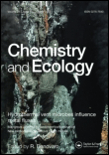
CHEMISTRY AND ECOLOGY
Bridging Disciplines for a Sustainable FutureCHEMISTRY AND ECOLOGY is a prestigious academic journal published by TAYLOR & FRANCIS LTD, dedicated to advancing the interdisciplinary understanding of chemical processes in ecological systems. With an ISSN of 0275-7540 and an E-ISSN of 1029-0370, this journal has been a significant contributor to the fields of Earth and Planetary Sciences, Ecology, and Environmental Science since its inception in 1982. The journal is proudly ranked in the second quartile (Q2) in multiple categories, including Earth and Planetary Sciences and Ecology, reflecting its high impact within these disciplines. Despite not being an open-access publication, it provides valuable insights through rigorous peer-reviewed articles that explore the intricate relationships between chemical phenomena and ecological dynamics. Researchers, professionals, and students can rely on CHEMISTRY AND ECOLOGY for the latest findings and methodologies that drive innovation and understanding in environmental chemistry and ecology, enhancing their work and education in this critical area of study.
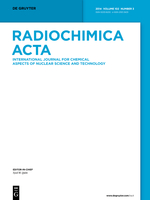
RADIOCHIMICA ACTA
Pioneering Research in Radioch Chemistry Since 1962RADIOCHIMICA ACTA, published by Walter de Gruyter GmbH, is a leading journal in the field of Physical and Theoretical Chemistry, with a storied history dating back to 1962. Based in Berlin, Germany, this esteemed journal serves as a vital platform for researchers, professionals, and students interested in the intricate interactions between radioactivity and chemical processes. With an impressive *Scopus rank* of 125 out of 189 and a *Category Quartile* ranking of Q3 for 2023, it is recognized for contributing significant findings to the scientific community. Although it currently does not provide open access options, RADIOCHIMICA ACTA continues to enrich the field through its commitment to disseminating high-quality research and critical reviews. As it converges toward its milestone year of 2024, the journal remains an essential resource for advancing knowledge in radioch Chemistry, shaping the future of theoretical explorations and practical applications alike.

Journal of Korean Society for Atmospheric Environment
Innovating solutions for cleaner air and a healthier planet.Journal of Korean Society for Atmospheric Environment is a leading platform for innovative research in the fields of environmental chemistry, engineering, and pollution science. Published by the Korean Society for Atmospheric Environment, this journal is dedicated to disseminating high-quality research findings that address the crucial challenges of atmospheric environment management and sustainability. The journal operates from South Korea and features a diverse range of articles exploring contemporary environmental issues, including air quality assessment and pollutant impact studies. Although it is not an open-access journal, it maintains a notable presence in the academic community with its categorization in Q3 in Environmental Engineering and Q4 in Environmental Chemistry, as of 2023. With its focus on interdisciplinary research, the Journal of Korean Society for Atmospheric Environment serves as an essential resource for researchers, professionals, and students interested in advancing knowledge and practices related to atmospheric environmental sciences.
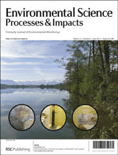
Environmental Science-Processes & Impacts
Advancing knowledge for a sustainable tomorrow.Environmental Science-Processes & Impacts is a premier journal published by the Royal Society of Chemistry, focusing on critical research in the field of environmental science. With ISSN 2050-7887 and E-ISSN 2050-7895, this journal has established itself as an authoritative source of knowledge since its inception in 2012, maintaining a remarkable Q1 quartile ranking across significant categories such as Environmental Chemistry, Management, Monitoring, Policy and Law, Medicine, and Public Health for the year 2023. It stands as an essential resource for professionals, researchers, and students, aimed at advancing scientific understanding and solutions to pressing environmental issues. With impressive ranks in Scopus, including #45 in Public Health and #27 in Environmental Chemistry, the journal provides a platform for impactful research and interdisciplinary collaboration, emphasizing open access to foster the dissemination of knowledge globally. Join a community committed to exploring the interconnectedness of environmental processes and their implications for society by contributing to or learning from cutting-edge studies published in this esteemed journal.

WATER AIR AND SOIL POLLUTION
Exploring the intersections of water, air, and soil for a cleaner planet.Water Air and Soil Pollution is a leading peer-reviewed journal published by Springer International Publishing AG, focusing on the vital fields of environmental sciences, ecological modeling, and pollution management. Since its inception in 1971, the journal has contributed significantly to advancing knowledge in the interdisciplinary realms of Water Science and Technology, Environmental Chemistry, and Environmental Engineering. With an impressive history, the journal currently holds a Q2 quartile ranking in several categories, reflecting its high impact and relevance in these essential areas of research. Its rankings—such as #95 in Environmental Science: Water Science and Technology—illustrate its standing in the academic community. Researchers and practitioners alike can access a wealth of studies and reviews that aim to address pressing environmental concerns and foster sustainable practices, although the journal is not Open Access. Located in Switzerland, Water Air and Soil Pollution continues to be a critical resource for those dedicated to understanding and mitigating pollution, making it an indispensable tool for anyone engaged in ecological and environmental research.
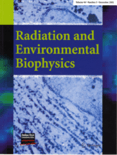
RADIATION AND ENVIRONMENTAL BIOPHYSICS
Unraveling the Complexities of Radiation InteractionsRADIATION AND ENVIRONMENTAL BIOPHYSICS, published by SPRINGER, is a premier journal dedicated to advancing the understanding of the interactions between radiation and biological systems within environmental contexts. With an ISSN of 0301-634X and an E-ISSN of 1432-2099, this journal has established itself as a vital source of innovative research across multiple disciplines, including Biophysics, Environmental Science, and Radiation Studies, maintaining a significant presence since its inception in 1974. The journal is categorized within the Q3 in Biophysics and Q2 in both Environmental Science and Radiation for 2023, indicating its relevance and influence in these domains. Researchers and professionals will find the journal's rich content invaluable, offering insights that could impact public health, environmental policy, and radiation safety. Although it is not an open-access journal, RADIATION AND ENVIRONMENTAL BIOPHYSICS provides critical information through its rigorous peer-reviewed articles, making it an essential resource for academics and practitioners aiming to contribute to this evolving field.
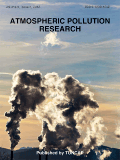
Atmospheric Pollution Research
Transforming air quality research into action.Atmospheric Pollution Research is a pivotal journal within the realms of Atmospheric Science and Environmental Science, published by the Turkish National Committee on Air Pollution Research and Control (TUNCAP). With an impressive impact, it holds a Q2 ranking in Atmospheric Science and Waste Management and Disposal, and a Q1 ranking in Pollution as of 2023, underscoring its significance and influence in the field. The journal's ISSN 1309-1042 facilitates the dissemination of cutting-edge research addressing contemporary issues in air quality and pollution management. Spanning a convergence of years from 2010 to 2024, it publishes original articles, reviews, and case studies that are essential for advancing knowledge in air pollution and its environmental impacts. Researchers, professionals, and students worldwide will find this journal to be an invaluable resource for staying updated on the latest findings and innovations aimed at mitigating the effects of atmospheric pollution.

JOURNAL OF RADIOANALYTICAL AND NUCLEAR CHEMISTRY
Advancing knowledge in radiochemistry and nuclear science.JOURNAL OF RADIOANALYTICAL AND NUCLEAR CHEMISTRY, published by Springer, serves as a vital platform for the dissemination of research in the fields of analytical chemistry, nuclear science, and radiochemistry. With an ISSN of 0236-5731 and an E-ISSN of 1588-2780, this journal has been a beacon of innovation and scholarly communication since its inception, transitioning from converged years of 1977-1979 to its current continuity from 1984 to 2024. Positioned in the Q3 category for analytical chemistry and other related fields such as health, toxicology, and nuclear engineering, it boasts significant standings in the Scopus rankings, reflecting its relevance and impact within these disciplines. The journal emphasizes open access, encouraging broader accessibility to quality research, which is critical for students, professionals, and ongoing global scientific discussions. As a leader in its domain, the JOURNAL OF RADIOANALYTICAL AND NUCLEAR CHEMISTRY is committed to advancing the understanding of radioactive materials, environmental safety, and health applications, ensuring its readers remain at the forefront of emerging trends and discoveries.
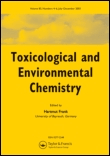
TOXICOLOGICAL AND ENVIRONMENTAL CHEMISTRY
Unraveling the complexities of chemicals and their environmental effects.TOXICOLOGICAL AND ENVIRONMENTAL CHEMISTRY is a pivotal journal published by Taylor & Francis Ltd, addressing critical intersections between environmental chemistry and toxicology since its inception in 1979. With its ISSN 0277-2248 and E-ISSN 1029-0486, the journal serves as a platform for rigorous research and innovative methodologies in pollution control, health implications of environmental chemicals, and the broader spectrum of toxicological studies. Although it currently does not offer open access, the journal's impact in the field is underscored by its Category Quartiles rankings in 2023, placing it in Q3 across Environmental Chemistry, Health, Toxicology and Mutagenesis, and Pollution categories. Furthermore, its Scopus rankings reveal its significant role within the scientific community, specifically in areas such as Environmental Science and Toxicology. The journal aspires to foster multidisciplinary dialogue and advance knowledge that contributes to environmental sustainability and public health, making it an essential resource for researchers, professionals, and students dedicated to these fields.
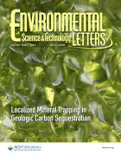
Environmental Science & Technology Letters
Advancing knowledge for a sustainable future.Environmental Science & Technology Letters, published by the American Chemical Society, stands as a premier journal in the realm of environmental science and technology, focusing on pivotal studies that address pressing environmental challenges. With an impressive Q1 ranking in multiple categories including Ecology, Environmental Chemistry, and Pollution, this journal maintains a position of excellence within its field, achieving Scopus ranks that place it in the top percentile of Environmental Science disciplines. Although not open access, Environmental Science & Technology Letters offers vital insights and cutting-edge research that contribute significantly to the understanding and management of environmental issues. The journal’s objectives include disseminating ground-breaking findings and promoting discussions that lead to sustainable solutions. With convergence from 2013 to 2024, it continues to serve as an essential resource for researchers, professionals, and students committed to advancing knowledge and innovation in environmental science.